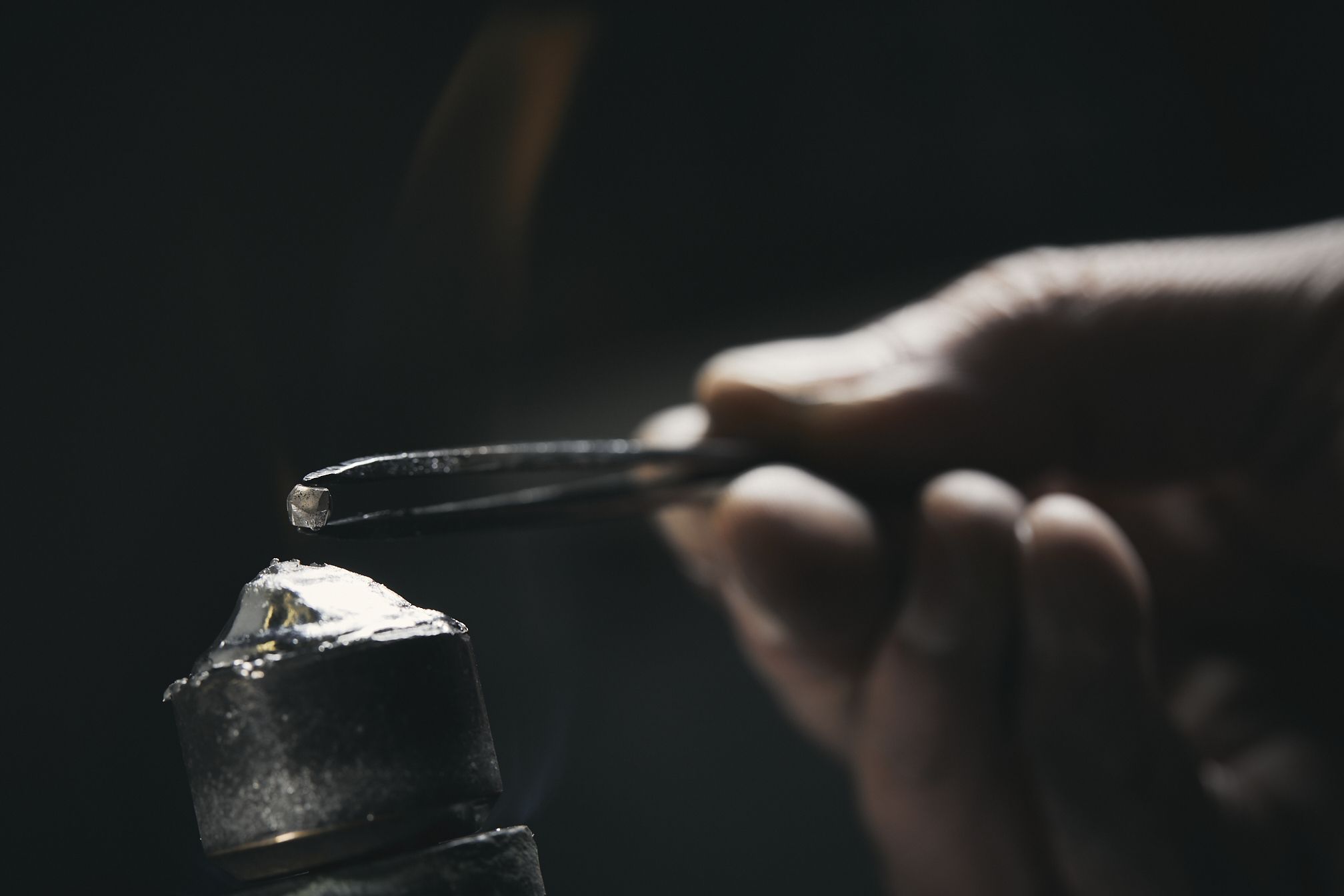Synthetic diamond tools
Synthetic diamond tools are useful for machining, such as dressing, roughing, finishing precious metals (gold, silver, platinum, aluminium, copper, bronze).
C2 manufactures both synthetic and natural diamond tools and in addition to the standard ranges, the C2 design studio is able to assist and provide advice to the customer to design and create custom tools according to the machining needsand thetasks to be carried out, even in the case of particularly complex angles and shaping.
How are synthetic diamonds made?
The difference between synthetic and natural diamonds depends on the production process. In fact, one takes place through technologies designed by man, the other through a geological process.
Synthetic diamonds can be obtained mainly through two methods: HPHT, High – Pressure High – Temperature (synthesis at high pressure and temperature) or CVD, Chemical Vapour Deposition.
The HPHT method consists of producing diamonds from graphite, a diamond allotropic, which differs from it only in its crystalline structure. Synthetic diamonds can be obtained by subjecting graphite to the typical environmental conditions of natural diamond formation. More specifically, the graphite is subjected to temperatures around 1,500 °C and pressures around 6 GPa.
The CVD method, on the other hand, consists of the continuous deposition of carbon from a plasma containing all the information necessary for the formation of the particular crystalline structure of a diamond. This process makes it possible to create synthetic diamonds with much lower temperatures and pressures than the previously mentioned method.
The first synthetic diamonds
The first documented attempts to make synthetic diamonds date back to the period between 1879 and 1928, but only from 1940, in the United States, Sweden and the Soviet Union, using the CVD and HPHO processes, did actual systematic research begin.
The first synthetic diamond was made in 1953 thanks to the HPHT method, while the CVD method was established in the early 2000s.
Advantages and properties of synthetic diamonds.
The creation of synthetic diamonds allows for greater control over imperfections. For this reason, synthetic diamond usually has much less impurities than natural diamond and consequently better properties. Moreover, thanks to the control that man can exercise in the creation of diamonds, some of their characteristics can be modified so that they are more in line with the use that will be made of them later on.
Hardness
The hardness of a synthetic diamond depends on its purity, crystalline perfection and orientation.In fact, thanks to covalent bonds extended to the entire structure and in all directions, the formation of a diamond is particularly stable and cohesive. On average, however, a synthetic diamond can reach a hardness of 10 on the Mohs scale and thanks to the use of specific applications it can be controlled more easily. This is why some monocrystalline synthetic diamonds and nano-crystalline HPHT diamonds may be harder than perfect diamonds found in nature.
Impurities and inclusions
Synthetic diamonds may have less impurities than natural diamonds. In fact, in nature diamonds may contain other atoms rather than just carbon. Such atoms can be aggregated into macroscopic phases called inclusions. Usually, when creating synthetic diamonds, impurities tend to be avoided, yet sometimes these can be intentionally introduced to control some properties of the diamond itself. For example, if boron is added to a synthetic diamond, a good electrical conductor can be obtained, while with the addition of nitrogen a diamond obtains greater hardness and resistance.
Thermal conductivity
Synthetic diamond are a good conductor of heat, thanks to the covalent bonds that form inside them. The thermal conductivity of pure diamonds is the highest known for solid objects. If a synthetic diamond is enriched with carbon (99.9%) it has 3,000 W·m −1 ·K −1 at room temperature, i.e. the highest thermal conductivity.
Lower cost
Synthetic diamonds usually have a lower cost than natural diamonds, and better properties, thanks to a reduced amount of impurities. Synthetic diamonds can therefore be expected to replace natural diamonds in industrial applications. Moreover, due to the historical intensive exploitation of natural diamond deposits, diamonds are becoming scarce and therefore their use in the industrial sector is uneconomic.
Mechanical machining and diamond tools
Synthetic diamonds are mainly used for industrial applications. In fact, thanks to their hardness and the characteristics seen above, they are perfect for making diamond-tipped tools, such as those produced by C2. C2 tools enable to carry out processes such as polishing, cutting, grinding and removal of precious metals (gold, silver, platinum, aluminium, copper, bronze).
Furthermore, diamond-tipped tools that have good thermal conductivity are also excellent for dissipating heat, generated during mechanical machining.
Diamond tools are not recommended for machining ferrous alloys. In fact at high temperatures carbon is very soluble in iron, and this leads to rapid wear of a chemical type.
C2 Diamond Tools
C2 manufactures both synthetic and natural diamond tools, and can customize tools according to the customer’s design.
Our range of diamond tools includes:
- Casters
- Hydro-copiers
- Posalux
- Milling cutters
- Hammers
- Ice Lathe Tools
- Vacuum tools
- Supply chains
C2 also offers a sharpening, restoration and maintenance service on all its tools, enabling to consistently carry out machining safely and efficiently.


